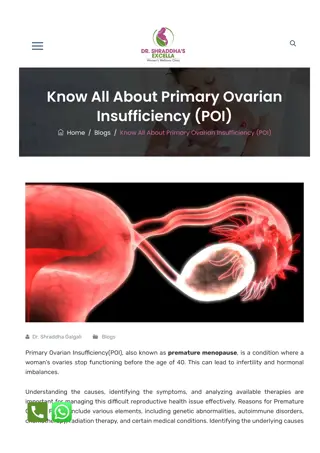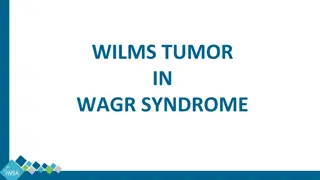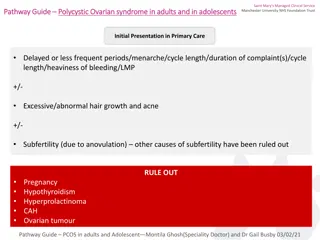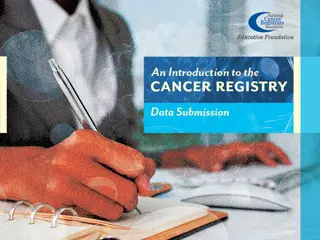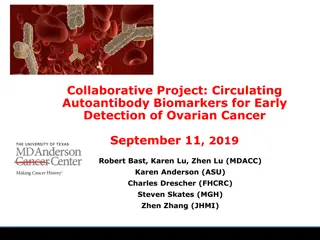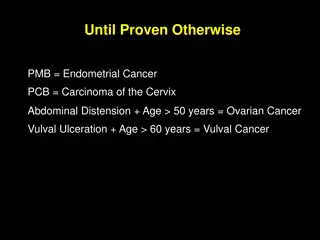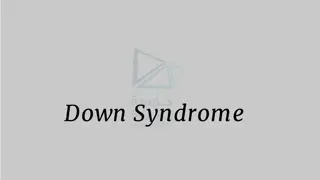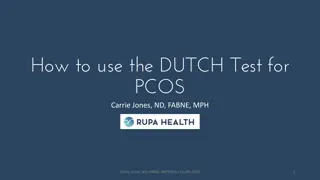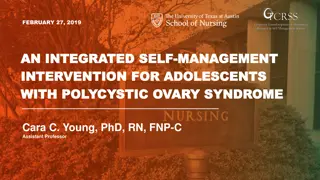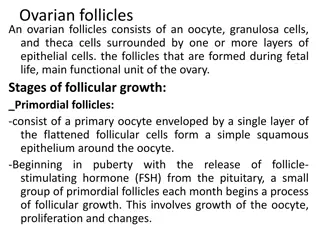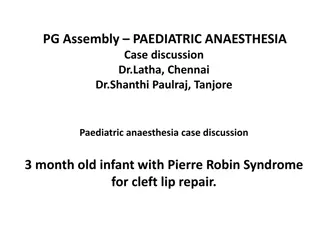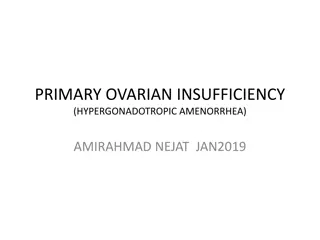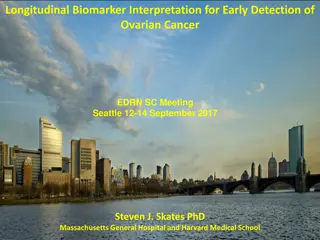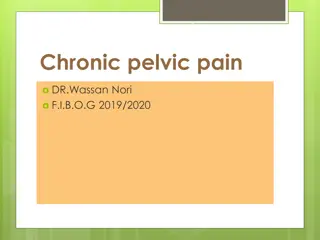Polycystic Ovarian Syndrome and Ovarian Cancer
"Explore the risk factors, causes, and treatments for polycystic ovarian syndrome (PCOS) and ovarian cancer. Learn about endocrine changes, insulin resistance, and hormonal imbalances affecting women's health. Delve into the diagnostic significance of CA-125 in ovarian cancer."
Download Presentation

Please find below an Image/Link to download the presentation.
The content on the website is provided AS IS for your information and personal use only. It may not be sold, licensed, or shared on other websites without obtaining consent from the author.If you encounter any issues during the download, it is possible that the publisher has removed the file from their server.
You are allowed to download the files provided on this website for personal or commercial use, subject to the condition that they are used lawfully. All files are the property of their respective owners.
The content on the website is provided AS IS for your information and personal use only. It may not be sold, licensed, or shared on other websites without obtaining consent from the author.
E N D
Presentation Transcript
HbA NH2 H2O2 Cl2O7 KClO3 NAOH CH2O PO4 KMnO4 M E D I C I N E COOH KING SAUD UNIVERSITY Co2 MgCl2 H2O SO2 Doctors slides Doctors notes Important ExtraInformation HCN CCl4 Editing file CuCl2 Editing file SiCl4 Biochemistry Biomarkers of ovarian cancer and cysts The best view comes after the hardest climb
O B J E C T I V E S By the end of this lecture, the students should be able to know: Discuss the risk factors and possible causes of polycystic ovarian syndrome (PCOS) and ovarian cancer. Comprehend the role of insulin resistance and hypersecretion of androgens in the development of PCOS. Identify avenues for the diagnosis and treatment of PCOS and ovarian cancer. Assess the diagnostic significance of CA-125 in ovarian cancer.
Polycystic ovarian syndrome It has another name (Stein-Leventhal syndrome). right it is called polycystic ovarian syndrome but the cyst maybe there and may be not there (may be very small that is doesn't show in the ultrasound). These cysts are immature follicles whose growth has been arrested . and they will cause menstrual irregularities which may lead to chronic anovulation or oligo-ovulation. Formation of multiple small cysts in the ovaries Affects 5-10% of women (20% in some populations) A major cause of infertility in women Strongly correlated to Family history Obesity (40%) Hypersecretion of leutinizing hormone (LH) and androgens (testosterone) Hirsutism because of androgen. Chronic anovulation Glucose intolerance Insulin resistance Hyperlipidemia Hypertension Menstrual disorders Low levels of SHBG (sex hormone-binding globulin) which is synthesized by liver.
Polycystic ovarian syndrome Polycystic ovarian syndrome Exact cause of the syndrome is unknown1 May be multifactorial (genetic and environmental)2 The probable causes are Insulin resistance causes excessive androgen production in ovaries (common)3 Abnormalities in ovaries, adrenal and pituitary glands 1: it is a syndrome that consists of a bunch of many things . 2: when we say its genetic that means there is family history. Another thing is that when the pregnant mother has condition that increase her androgen level (e.g. Cushing syndrome) then the child will expose to this high amount of androgen and she (the child) may develop PCOS later.
Endocrine changes in PCOS When you have Androgen excess it may be because of high insulin amounts (because of obesity) that can lead to decreased production of the sex hormone binding globulin (SHBG), then you will have more Free (active) testosterone which will lead to the common symptoms of androgens like acne & male pattern of hair loss. These excess androgens will go to the adipose tissue and these adipose tissue has the enzyme aromatase which converts the testosterone to oestrone, which increases the release of LH and decrease the FSH. FSH decrease will cause anovulation, while Increased LH will stimulate theca cells that produce more and more androgens and the cycle will repeat. So, if you want to treat PCOS you have to break this cycle (details in the next slides)
Diagnostic criteria for PCOS European Society for Human Reproduction & Embryology (ESHRE) and American Society for Reproductive Medicine (ASRM) recommendation: At least TWO of the following features are required for PCOS diagnosis: (if she has only two she can be diagnosed by PCOS) 1. Oligo-ovulation or anovulation manifested as oligomenorrhea4 or amenorrhea 2. Hyperandrogenism (clinical and biochemical evidence of androgen excess) 3. Polycystic ovaries (as defined by ultrasonography) 4: No period for at least 6 months.
Polycystic ovarian syndrome Diagnosis done by measuring: Free testosterone (total testosterone is less sensitive; androgens are increased in PCOS) Because there is low amount of SHBG, and because of this the androgens will be high. Sex hormone-binding globulin (SHBG; decreased in PCOS) Luteinizing hormone (LH; high in 60% cases) Follicle stimulating hormone (FSH); usually normal in PCOS Measuring the following the LH to FSH Ratio is the most important thing Fasting blood glucose Insulin will increase Lipids will increase (Hyperlipidemia) 30% of patients do not have ovarian cysts despite having symptoms Ovarian ultrasound (usually the size of the cyst is 2-6 mm) Treatment of PCOS: Break the cycle
Treatment of PCOS Aim of treatment: interrupt the cycle of obesity, insulin resistance, excess androgens. Reduce LH levels (by oral contraceptives). Reduce body weight which will increase insulin sensitivity. and you also can prescribe metformin. Increase FSH levels (by clomiphene, etc.) Estrogen replacement therapy: In select women after careful risk counseling.
Ovarian cancer A leading cause of death because of gynecologic cancer. Due to malignant transformation of ovarian epithelial cells, there are other types but this is the most common. Most common type of ovarian cancer. Subtypes: 1. Serous (46%): surface epithelial tumors. (most common) 2. Mucinous (36%): mucinous epithelial tumors. 3. Endometrioid (8%): endometrial tumors
Ovarian cancer Risk factors: Increase in Age is a risk factor and its important. 1. Nulliparity (woman with no child birth or pregnancy). 2. Family history of breast, ovarian, colorectal cancer. First degree relative, or the person herself had history of cancer. 3. Mutations in BRCA1 and BRCA2 genes (most common). 4. Carriers of BRCA1 mutations have a cancer risk of 44%. 5. Premenopausal breast cancer or ovarian cancer indicates higher risk for hereditary or breast cancer. If one of the family members developed cancer before menopause this increases the risk of cancer for other relatives. 6. Ashkenazi Jews have higher risk of ovarian cancer.
Ovarian cancer Biomarkers and diagnosis: Epithelial ovarian cancer is commonly diagnosed at a later stage. Due to non-specific symptoms such as abdominal pain, blotting, early satiety, nausea, etc. Most patients (75%) have advanced-stage tumor upon diagnosis (you will be able to feel an abdominal mass in clinical examinations) Diagnosis includes: 2. Physical examination. 1. History taking. 3. Ultrasound. 4. Measurement of serum CA-125 levels . (Age of menarche any history of cancer) (mass , ascites, pleural effusion) (transvaginal)
Cancer antigen 125 (CA-125) The only serum marker of epithelial ovarian cancer. A cell surface glycoprotein expressed in the epithelium of all tissues (Ovarian cells and other tissues). Normally absent in serum. If it s high in blood it may indicate ovarian cancer especially in post-menopausal women, but in pre-menopausal it may be increase due to many situations like presence of fibroids, menstrual cycle or first trimester of pregnancy. So, it s is not specific.. That's why they use it to follow up during treatment. Recommended as an annual test for women with family history of ovarian cancer (you don t screen the whole population for this marker except they are at high risk of developing ovarian cancer). CA-125 is associated with stages of ovarian cancer. CA-125 is elevated in ovarian cancer (>35 U/ml is considered positive). Cancer antigen 125 (CA-125) is Elevated in: 1. 50% of patients with stage I 2. 90% of patients with stage II 3. >90% of patients with stage III and IV
Cancer antigen 125 (CA-125) CA-125 is not a marker of choice for ovarian cancer screening due to: 1. High false-positive rate. 2. Low prevalence of ovarian cancer A non-specific marker. False positive CA-125 conc. are found in benign conditions: 1. Endometriosis. 2. Uterine leiomyomas. 3. Pelvic inflammatory disease. 4. During the first trimester of pregnancy. 5. During menstruation. - Some patients (< 50 years) have elevated CA-125 due to unrelated malignant mass especially if there is ascites.
Ovarian cancer Cancer antigen 125 (CA-125) is useful in: Monitoring patient s response to chemotherapy. Success of surgery (de-bulking procedures). removing the tumor masses Annual testing for women with family history of ovarian cancer.
Take Home Message PCOS is strongly correlated to insulin resistance and endocrine abnormalities. Although a nonspecific biomarker, CA-125 is important for staging and follow- up of ovarian cancer treatment
Changes in PCOS Formation of multiple small cysts in the ovaries LH Polycystic Ovarian Syndrome FSH Affects 5-10% LH stimulates ovarian stroma & theca Plasma oestrone Aromatization in adipose tissue Androgens Obesity SHBG Malignant transformation of ovarian epithelial cells Ovarian Cancer Treatment: Breaking the cycle Serous (46%) Mucinous (36%) Endometrioid (8%) Insulin resistance CA-125 Serum marker: A cell surface glycoprotein expressed in the epithelium of all tissues Ovarian cancer+ >35 U/ml
QUIZ Q1 : Which one of the following drugs is used in the treatment of polycystic ovarian syndrome to increase FSH levels? A. Oral Contraceptives B. Clomiphene C. Estrogen replacement D. Estradiol Q4 : Which one of the following is a serum marker of epithelia ovarian cancer? A. BRCA 1 B. BRCA 2 C. Cancer antigen 125 D. RIKA-B Q5 :Which one of the following is a direct cause of hirsutism in Polycystic ovarian syndrome? A. Increased plasma Oestrone B. Anovulation C. Increased LH D. Increased Androgens Q2 : Which one of the following is correct in terms of the diagnostic criteria suggested by ESHRE & ASRM to diagnose Polycystic ovarian syndrome? A. Oligo-ovulation + anovulation B. Polycystic ovaries + Insulin resistance C. Hyperandrogenism + obesity D. Oligo-menorrhea + Hyperandrogenism Q6 : A 39 nulliparous patient came in with complains of abdominal pain, upon ultrasound ovarian cysts were found. Which one of the following findings would confirm the diagnosis as polycystic ovarian syndrome? A. Amenorrhea B. BRCA 1 mutation C. Positive CA-125 D. Decreased LH Q3: Which one of the following is the most common subtype of ovarian cancer? A. Serous B. Mucinous C. Clear cell D. Endometrioid
QUIZ C) Mention 3 situations that the CA-125 is useful in. 1. Monitoring patient s response to chemotherapy 2. Success of surgery 3. Annual testing for women with family history of ovarian cancer Q7 : You are a medical student that has finished the reproduction block biochemistry lectures and have become a very knowledgeable person. As you are walking down the street with a friend you saw a woman with a mustache, your friend recalled a few questions to review your knowledge about biochemistry. D) Mention 4 methods used in the treatment of polycystic ovarian syndrome. 1. Reduce LH levels: by using oral contraceptives. 2. Reduce body weight 3. Increase FSH level: by using Clomiphene 4. Estrogen replacement therapy A) Name 7 criteria that are measured for the diagnosis of Polycystic ovarian syndrome and what is the finding if the pathology is present? 1. Free testosterone: Increased 2. Sex hormone-binding globulin: Decreased 3. Leutinizing hormone: Increased in 60% of cases 4. Follicle stimulating hormone: Normal 5. Fasting blood glucose: Increased 6. Insulin: Increased 7. Lipids: Increased B) Mention 1 radiological method used for conformation of the diagnosis of PCOS. 1. Ovarian Ultrasound Suggestions and recommendations Suggestions and recommendations 1) B 2) D 3) A 4) C 5) D 6) A
THANK YOU FOR CHECKING OUR WORK T E A M M E M B E R S TEAM LEADERS PLEASE CONTACT US IF YOU HAVE ANY ISSUE Laila mathkour Mohammad Almutlaq Rania Alessa Haneen alsubki Zainah alkaff Abdulaziz alhusaini Abdulrahman alrashed





